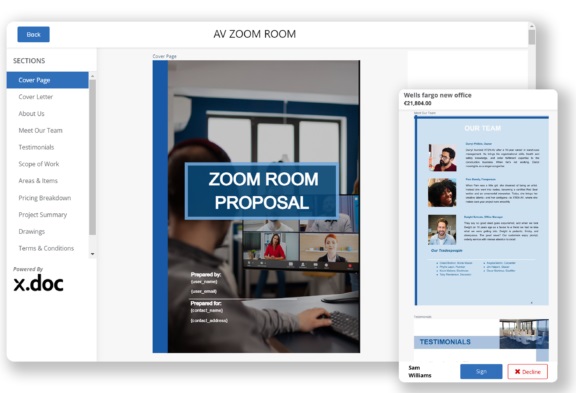11 Bid Proposal Mistakes and Bidding Errors You Are Probably Making
You are burning the midnight oil to submit yet another bid proposal and are confident that it perfectly captures the client’s needs. But does it? Don’t press the send button yet. You may be making painful bid mistakes that you don’t even realize. Avoid client frustration by keeping these 11 common bid proposal mistakes in mind. Once you have an airtight bid process, you will rest easy.
Key Takeaways
- Understand what bid proposals are and it’s key elements.
- Discover the common mistakes you make while writing a bid proposal.
- Knowing what to include and not to in a bid proposal.
- Tips on how to write a bid proposal using x.doc.
What is a Bid Proposal?
A bid proposal is a comprehensive document crafted by a business to pitch its goods or services to a potential client. It’s more than a price quote. It’s a strategic tool designed to persuade the client that your company is the ideal partner for the project.
Key elements of a bid proposal include:
Here are the 5 key elements of bid proposal you need to consider while drafting business proposal template:
- A concise overview highlights your understanding of the client’s needs and your solution’s value.
- Information about your company’s expertise, experience, and qualifications.
- A detailed description of how to address the client’s requirements, including costs.
- A transparent breakdown of the project’s costs, including materials, labor, and additional fees.
- The legal framework outlines the expectations and responsibilities of both parties.
11 Bid Proposal Mistakes That Can Derail Your Success
Winning a bid is often a make-or-break moment for businesses. Yet, countless proposals need to be revised due to avoidable mistakes. Don’t let your hard work go to waste! Here’s a breakdown of common bid proposal mistakes that you make while creating one.
Failing to meet the expectations
Have you ever submitted a bid proposal without actually meeting all the requirements? That’s a big mistake. Make sure you have addressed each requirement and pain point the client has mentioned. If you can’t meet specific needs, be upfront about it. You are wasting everyone’s time if you bid on any work which you can’t do.
Promoting rather than proposing solutions
A bid proposal is not meant to be a marketing document. While you want to highlight your experience and qualifications, the focus should be on how you will address the client’s specific needs. Provide details about your proposed solution, method, timeline, and costs. Don’t promote your business in any manner.
Ignoring the pain points
The RFP often identifies key challenges or areas for improvement. Be sure to address directly how your solution will solve these pain points. If the client mentions a problem with their current process, explain how you will fix or improve it. Your bid will be more compelling if you understand their key issues.
Too much jargon
While you want to demonstrate your expertise, avoid overloading the proposal with industry jargon. Use clear, straightforward language that any reader can understand. After all, the evaluation committee may include some less technical individuals. Even for experts, too much jargon can come across as obscure. Focus on communicating your message in the simplest terms possible.
Overlooking risks
Every project has risks, so address them when you write a bid proposal. Discuss potential challenges, obstacles, and complications, and how you will mitigate them. This shows the client you have a realistic understanding of the work involved. Don’t highlight the positive – be transparent about risks, too.
Not asking enough questions
Before submitting your bid, make sure you have asked the client plenty of questions. The more you understand about needs, goals, resources, and priorities, the more tailored and compelling your proposal can be. Ask about budget, deadlines, decision-making processes, and key metrics for success. Thoroughly vet the project, then submit a proposal that addresses all elements.
Not requesting feedback
Failing to ask for feedback after submitting a proposal is a huge missed opportunity. Your potential client has valuable insights into why your bid did or didn’t win. Asking thoughtful questions about their decision-making process demonstrates genuine interest in their needs. It also gives you actionable information to make your next proposal even stronger.
Not factoring overtime
Complex, labor-intensive projects require overtime to complete successfully. When submitting your bid, ensure you account for these extra hours to reflect the project’s cost and timeline. Not including overtime estimates makes it seem like you need to understand the scope of work or plan for contingencies. Your potential client will likely see right through an unrealistic bid, damaging your credibility.
Last-minute bids
Developing an amazing proposal takes time. Rushing to submit a bid at the last second often results in a disorganized, poorly-written proposal full of errors. You end up reusing generic content that doesn’t speak directly to the client’s needs. Last-minute bids need to reflect better on your ability to plan ahead and manage projects. Do yourself a favor and start the proposal process as early as possible.
Submitting without review
Even the most experienced bid writers benefit from getting another set of eyes on their work. Having a colleague review your proposal helps identify any remaining issues. They may notice phrases that could be misinterpreted or see opportunities for improvement you have missed. A fair review also ensures your proposal is compelling and error-free before submitting. Don’t skip this important step.
Not using technology
Leveraging technology to design an eye-catching yet readable proposal gives you a huge advantage. Use tools like graphic design software to develop custom graphics and layouts. Interactive PDFs or web-based proposals help bring your solution to life. Video testimonials from happy clients are memorable and persuasive. Technology allows you to create a polished multimedia experience your competitors may need help with.
How to write a bid proposal with x.doc?
You are likely to manage multiple proposals at once, struggle to keep track of progress, and spend countless hours switching between tools like MS Excel, MS Word, and e-signature platforms. This is where x.doc comes in.
x.doc streamlines the bid proposal creation process. This business proposal management software ensures that your submissions are professional and persuasive. Here’s a simplified guide on how you can write bid proposals using x.doc.
- Choose a DFY Template: Select from x.doc’s 100+ proposal templates, including specific job proposal templates, to get started.
- Customize: Use the 100% customizable interface to tailor the template to your specific needs and brand identity.
- Edit and Style: Utilize the user-friendly editing tools to refine the content and style of your proposal, ensuring a polished look.
- Utilize Digital Signatures: Take advantage of x.doc’s legally binding digital signature feature to ease the signing process.
- Track Your Proposal: Keep tabs on your proposal’s progress with real-time tracking and gain insights into client interactions.
- Achieve the Best Results: Use x.doc to create standout proposals and set yourself apart from the competition.
100+ Free Proposal Templates
- Create Winning Proposals
- 10x Your Closing Rate
- Efficient Document Tracking
- Legally Binding Digital Signatures
- Best Editing & Styling Features
Your Bid Proposal is Your Sales Pitch
Paying attention to these often-overlooked details will transform your next bid proposal from average to award-winning. Submitting a well-crafted proposal that addresses your client’s key concerns is the first step to winning their business. Avoid these bid proposal mistakes and watch your success rate soar.
Ready to win more bids? Don’t let proposal design hold you back. Elevate your proposals with x.doc’s intuitive interface and professionally designed templates. Start your free 15-day trial today and see the difference x.doc can make for your business.
FAQs
The client rejects a bid if it doesn’t meet their requirements or contains errors. They may also reject it for uncompetitive pricing or late submission. Non-compliance with bid submission guidelines can also lead to rejection.
Bidding failure can occur for many reasons. Some common reasons include not understanding the client’s needs, submitting a poor proposal, or lacking relevant experience.
Smart bidding starts with understanding client needs and tailoring your proposal. It also involves competitive pricing, showcasing your expertise, and timely submission of an error-free proposal.
The bid method is a procurement process. Potential suppliers or contractors submit competitive bids to win a contract. The client evaluates bids based on predefined criteria. The contract is then awarded to the most suitable bidder.

